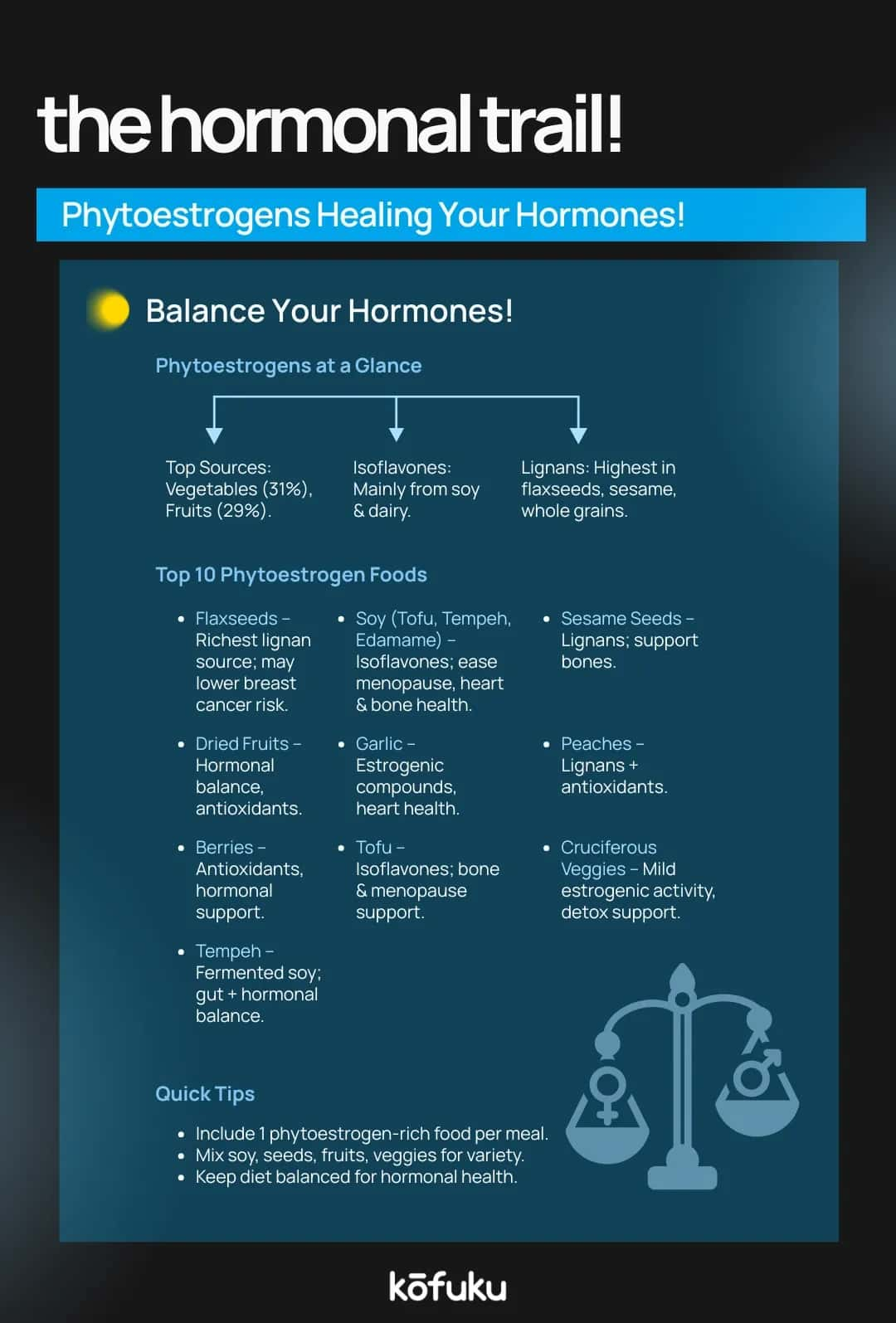10 Foods Rich in Phytoestrogens to Naturally Support Hormonal Balance

Introduction
We’re constantly undergoing some sort of life changes, but when it comes to hormones, you cannot take these changes lightly. During the peri-menopausal phase, you may experience hormonal fluctuations, which can be concerning at times.
Phytoestrogens, plant-based compounds that have estrogenic properties, can provide some solid support for your hormonal health during these times of change.
Let’s take a look at what phytoestrogens are, why they matter, and the 10 top foods that are naturally rich in phytoestrogens.
What are Phytoestrogens and Why Are They Important?
Phytoestrogens are compounds that are derived from plants and are found in over 300 plant species. They share a similar structure with the estrogens produced by our bodies and attach to estrogen receptors, acting as weak estrogens or modulators. They support people with low levels of hormones, such as during menopause.
Studies show that phytoestrogens help reduce menopausal symptoms like hot flashes, support bone health, and offer antioxidant and potential heart-protective benefits. However, evidence on these benefits is still inconclusive, and the dosage you take plays a massive role in its effectiveness as well.
Top 10 Phytoestrogen Foods That Should Be a Part of Your Diet
Flaxseeds (Linseed)
Flaxseeds are a rich source of lignans, which are phytoestrogens that our gut can metabolise into active anti-cancer compounds. Flaxseeds are also a good source of fibre and contain omega-3 fatty acids, which are beneficial for your gut health.
Soybeans & Edamame
Soy is a well-known source of isoflavones, including genistein and daidzein. Soybeans have been researched extensively for their effects on bone density, heart health, and relief from menopausal symptoms.
Tofu
Derived from soybeans, tofu is rich in isoflavones and is a great protein-dense addition to other foods. You can eat tofu as is or combine it with different foods to maximise its benefits.
Tempeh
A fermented soy product with isoflavones, tempeh is among the best sources of bioavailable isoflavones when compared to non-fermented forms of soy. It is also great for people who are on a cut and want vegan protein options.

Sesame Seeds
Sesame seeds are dense in lignans, a powerful source of phytoestrogens. They are also a rich source of calcium and minerals.
Dried Fruits (Figs, Dried Apricots, Medjool Dates, Prunes)
Dried fruits contain lignans as well as antioxidants and fibre, of course, which are great for your hormonal and overall health.
Chickpeas & Lentils
Legumes, including chickpeas, contain phytoestrogens and act as a source of protein, iron, and fibre.
Cruciferous Vegetables (Broccoli, Brussels sprouts)
Cruciferous vegetables contain phytoestrogens and glucosinolates, which provide hormonal support and detoxification.
Berries & Peaches
Berries, especially grapes and peaches, contain low levels of phytoestrogens, but also provide antioxidants such as resveratrol.
Whole Grains & Seeds (Oats, Wheat, Barley)
Whole grains are abundant in lignans and support your gut health and metabolism.
Why These Foods Help Hormonal Balance
These nutrient-rich foods are great to boost and maintain your health. Here’s why and how they are essential for your hormones:
Menopausal Support
Phytoestrogens bind to the estrogen receptors when estrogen levels decrease and can help ease hot flashes, mood swings, and sleep disruptions.

Bone & Heart Health
Isoflavones and lignans help enhance bone density and cardiovascular health. The antioxidant and anti-inflammatory effects of these substances lower the risk of cancer and diabetes.
Gut Health & Hormone Metabolism
Plant lignans need the right gut microbiota to be converted into active components. Fermented food sources, such as tempeh or kimchi, help facilitate these mechanisms and enhance your gut health and metabolism.
How to Incorporate These Estrogen-Rich Foods
- Sprinkle about 1–2 tablespoons of flaxseeds over your breakfast cereal or smoothie.
- Snack on soy-based products, such as tofu stir-fries, tempeh curries, or edamame.
- Enjoy roasted chickpeas, or add lentils to salads and soups for a nutritious addition.
- Add seeds like sesame or pumpkin to yoghurts, salads, or veggie bowls.
- Add dried fruit slices to oats at breakfast or in a homemade trail mix.
- Make sautéed vegetables, such as broccoli and Brussels sprouts, a part of your weekly routine.
- Use wholegrain oats, barley, or wheat bread at least a few times a week.
Who Benefits Most from Phytoestrogens and When to Use Caution
People in the perimenopausal and menopausal phases benefit the most from the use of phytoestrogens. A diet rich in phytoestrogens helps reduce menopause symptoms and provides increased support for bone and heart health.
However, people who are hormone-sensitive, pregnant, or on cancer medications need to consult their doctors before using phytoestrogens. It could be potentially risky if you consume very high doses of phytoestrogens in some contexts. It is also crucial to consult with your paediatrician before including these foods in an infant’s formula or diet.
Individuals who are lactating should consume phytoestrogen-rich foods with caution, as part of a balanced diet, or under a doctor’s advice. This is because while these are good for your overall health, they can have a negative impact or reaction to the hormone responsible for milk production.
So, it is crucial to ensure that it is part of your meal as a dietary support and in moderation. If you notice any reactions or are worried, consult your doctor immediately.
Conclusion
Adding a range of foods rich in phytoestrogen, particularly soy, flaxseeds, legumes, seeds, and berries, can gently support your body’s estrogen receptors and provide health benefits through antioxidant, anti-inflammatory, and metabolic pathways.
These plant-based foods are excellent at balancing your hormones, particularly for women experiencing hormonal changes during the midlife stage of life.
Phytoestrogens are not a cure-all; however, they definitely are promising and a great addition to a balanced, whole-food diet that can help enhance the quality of your life.

FAQs
Q. What are the best estrogen-rich foods to eat daily?
A. Flaxseeds, soy foods, sesame seeds, legumes, berries, dried fruit, and whole grains are some of the best foods to incorporate into your everyday diet.
Q. How does soya isoflavone help increase estrogen naturally?
A. Soy isoflavones act like estrogen in the body and bind to its receptors, helping to deal with low levels of estrogen.
Q. Can dry fig during pregnancy support hormone health?
A. Dried figs have lignans, so if you’re pregnant, then consult a doctor before trying any new phytoestrogens.
Q. What are safe estrogen-increasing foods for breastfeeding moms?
A. Follow a moderate intake of phytoestrogens, such as tofu, oats, flaxseed, and legumes, once your doctor gives you the green light.
Q. How to include flaxseeds and fig seeds in your diet?
A. Sprinkle flax seeds on top of your cereal or add them to smoothies. You can also try adding dried figs or fig seeds to your oatmeal and salads.

18 Best Healthy Foods to Gain Weight Quickly and Safely

Dangers of Using Smoky Liquid Nitrogen in Food

10 Food Items for the Hot and Humid Summer Months

Antioxidant Foods in India: Why They Matter for Your Health

Tests for Food Allergies: Why Getting the Right Diagnosis Matters

6 Effective Foods That May Block DHT and Help Fight Hair Loss Naturally

Lauki Soup: A Simple and Wholesome Food


